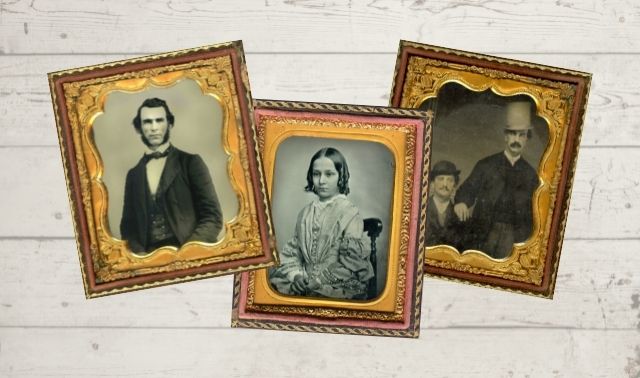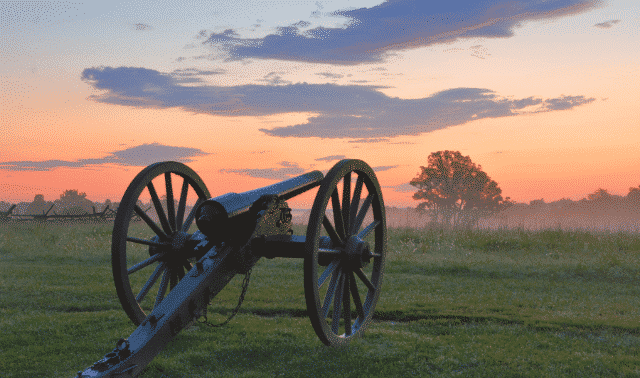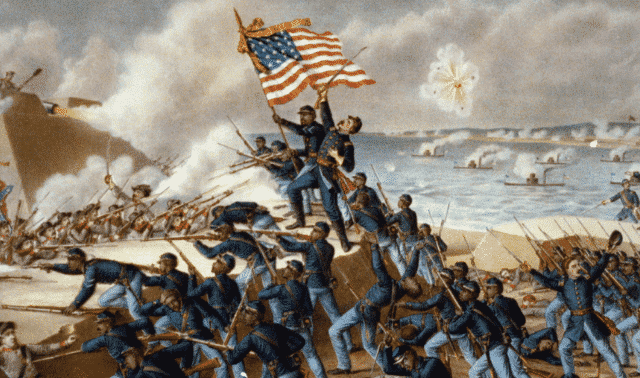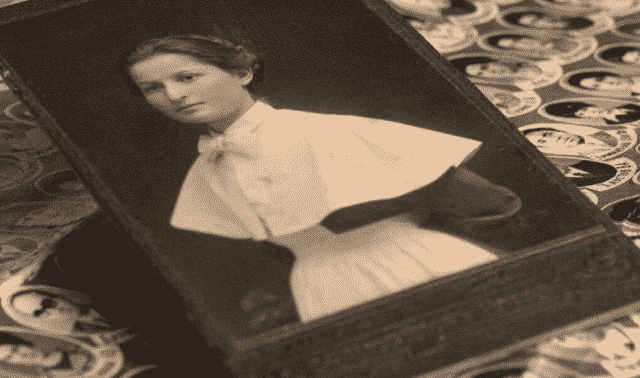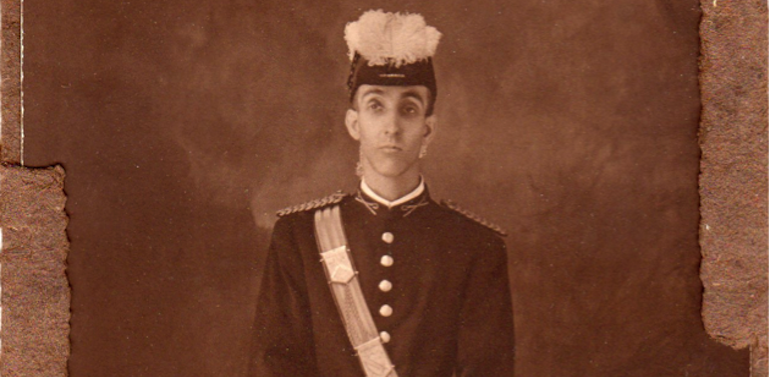Sign up for the Family Tree Newsletter Plus, you’ll receive our 10 Essential Genealogy Research Forms PDF as a special thank you!
Get Your Free Genealogy Forms
"*" indicates required fields
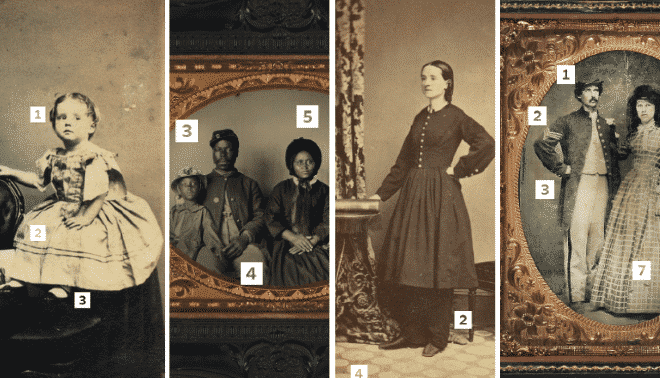
By the time of the Civil War, photographic technology had developed to the point that many families possessed cherished photos of their soldiers and even card photos of famous generals. The shiny, reflective daguerreotype was waning in popularity. Glass ambrotypes were still widely available, but the most fashionable opted for more-durable tintypes (actually printed on iron plates) or cartes de visite paper prints. While the photographic industry flourished in northern states, blockades on southern ports prevented the importation of supplies. The price of photographs fluctuated during the war, with ambrotypes dipping as low as 25 cents and cartes de visite at a dollar.
Itinerant tintype photographers followed Civil War troops, selling the soldiers portraits—their last, perhaps—to mail home with letters. Advertising for a war-era innovation, American-made photo albums, suggested that every soldier should own one.
If you’re lucky enough to have photos of your Civil War-era ancestors, there are a few strategies you can use to tease our more information about those pictured. We’ll cover a few of these strategies, then walk through a few examples of Civil War-era photos and the different clues revealed in the type of image, the case enclosing it (if any), the clothing your ancestors wore, and the props and backdrop around them. As you’ll see, the tiniest details can lead to new information. For now, let’s cover some basic strategies to apply to your Civil War-era photo research.
Tax Stamps
A quick way to date a Civil War picture might be on the back. The government taxed photographs from Aug. 1, 1864, to Aug. 1, 1866, so turn over your images to look for a tax stamp. Stamps were supposed to bear the photographer’s initials and a date, but many studios didn’t fully comply. A stamp’s value hints at the photo’s purchase price: A two-cent stamp was placed on images costing less than 25 cents. A three-cent stamp indicates the image cost 25 to 50 cents, and a five-cent stamp indicates a cost of 51 cents to $1. Six months before the law was repealed, the government added a one-cent stamp for photos worth less than a dime.
Civil War Fashion Trends
Despite the economically depressed war era, our ancestors observed fashion trends. The evidence is in family photographs from the period. Women gazed at the color fashion plates in magazines such as Godey’s Lady’s Book to follow the trends, and they created accessories from pocketbooks to collars and shawls. Civilian men made a statement with caps and hats. Enlisted men and officers wore uniforms in a wide array of colors—not just blue and gray. Boys wore pants or, for the youngest ones, dresses, while girls wore styles imitating Mom.
10 Examples of Civil War Photos
It’s all well and good to talk about strategies for photo research but why not see these strategies in action? Below we have nine examples of photographs from the Civil War era; take a look and see how the subtle details can lead to more information.
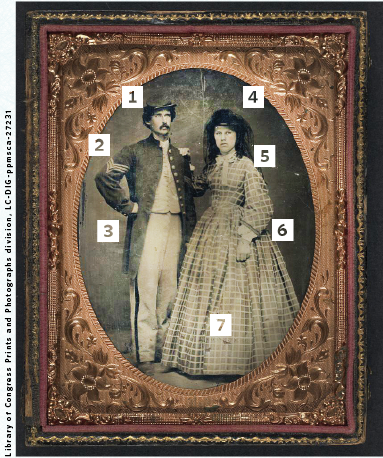
Paired Up
- The kepi (or forage cap) was common during the Civil War. Puffed Whipple caps, slouch hats and broad-brimmed low-crowned felt hats were among the styles various units wore.
- The chevrons on this man’s sleeve identify him as a sergeant, a noncommissioned officer.
- Neither Union nor Confederacy had standard uniforms. That means uniform styles can help you pinpoint the unit in which a man served; many are illustrated in Uniforms of the Civil War: An Illustrated Guide for Historians, Collectors, and Reenactors by Robin Smith and Ron Field (The Lyons Press).
- Hat and bonnet styles varied with the season, location and occasion. The netting on this hat suggests it’s a warm day.
- War-era dresses featured small collars in a variety of styles, such as this woman’s rounded collar and bow.
- Short sleeves showed off undersleeves, which weren’t attached to the dress, but rather tied to the arm.
- The fullness of the skirt hints at a hoop frame underneath.
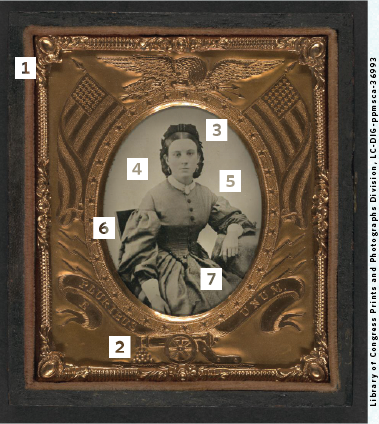
Woman’s Day
- Tintypes could be encased or not.
- The flags, cannon and phrase “E Pluribus Unum” on the mat are patriotic motifs common during the Civil War period.
- This unidentified woman has gathered her hair in a snood with a ribbon atop her head.
- Many young women wore earrings for portraits in this period.
- This Peter Pan-style collar accessorized with an oval pin is typical of the mid-1860s.
- Full, off-the-shoulder sleeves with white undersleeves add fashionable detail.
- The bodice features a trimmed point at the waistline. Like most other dresses of the time, this one buttons down the front.
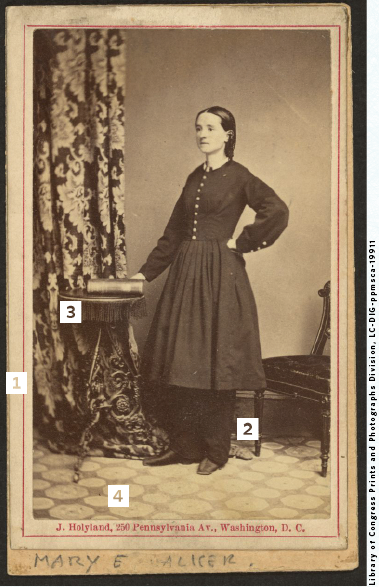
Reform Movement
- Card photographs, or cartes de visite, introduced in America in the late 1850s, were extremely popular during the Civil War. Our ancestors could buy cards of famous people including this woman, Civil War surgeon Mary E. Walker.
- As a doctor, Walker needed functional attire. The short dress with long pants was known as the reform dress, endorsed by a women’s rights advocates called Dress Reformers. Similarly, millworkers wore short skirts to keep from being caught in machinery.
- Standard studio props included drapery, chairs, tables and books. Chairs and tables gave patrons a place to display belongings and provided support to remain still.
- Mid-19th-century studios often had oilcloth floor coverings.
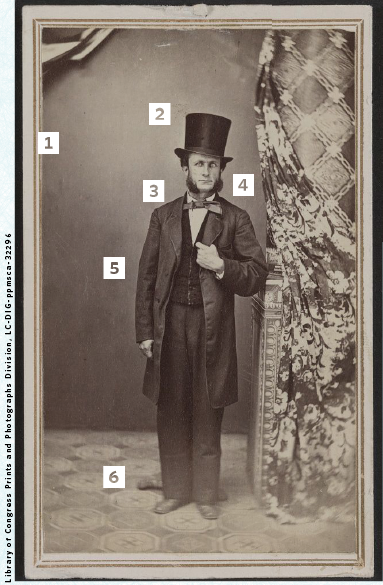
Hat’s On
- Single or double gold-lined borders on cartes de visite appealed to the public throughout the 1860s.
- Tall hats were fashionable for distinguished men. This portrait shows William Lyttle of Fort Wayne, Ind.
- This style of tie wrapped around the neck under the collar.
- Union Gen. Ambrose Burnside lent his name to facial hair known as sideburns.
- Men of note wore long frock coats, vests and stovepipe hats, commonly seen in photos of Abraham Lincoln.
- Photographers used braces with clamps to hold clients still. Notice the brace behind Lyttle’s feet.
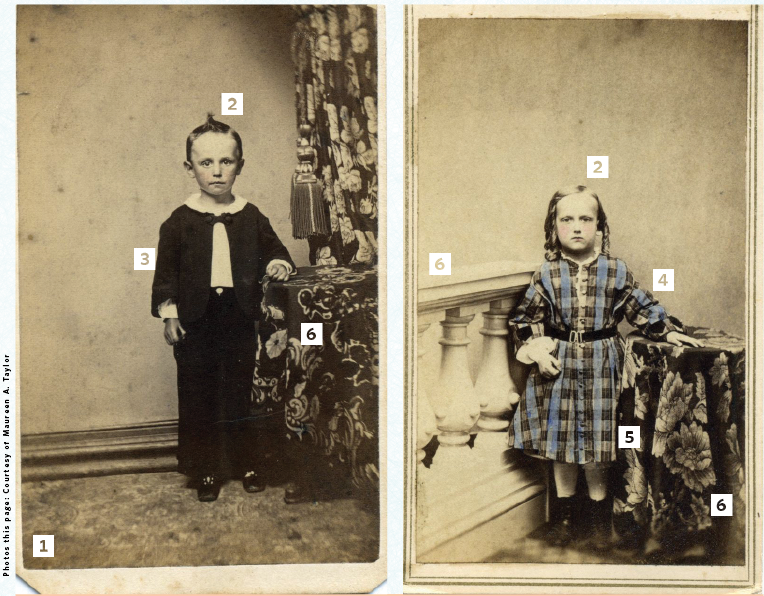
Oh, Boys
- The clipped corners of this carte de visite suggest it was once in an album.
- Look at the hair to determine a child’s gender. Both of these unidentified boys wear side parts; girls’ hair would be parted in the center. Boys might wear their hair short or in long curls.
- School-aged boys wore pants and short jackets.
- Toddler boys often wore a style called a French dress. It was belted at the waist and worn with stocking and short boots.
- Photo studios offered a range of coloring services. This boy’s dress plaid was tinted blue.
- Common studio décor included balustrades and fabric-covered tables.
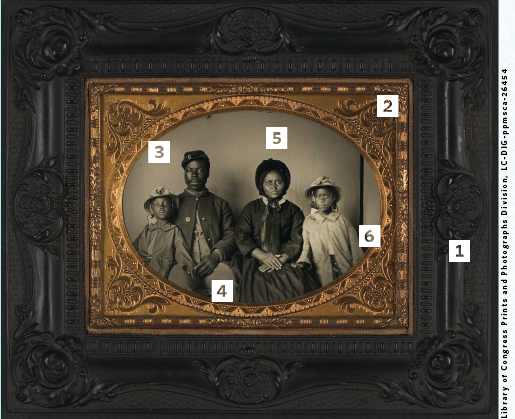
Family Time
- This cased ambrotype frame is meant to hang on a wall.
- Ambrotype cases could be wood, leather, mother of pearl or thermoplastic with designs ranging from floral to geometric.
- The provenance of a photo can help identify it. This one was found in Cecil County, Md., making it likely the father served in one of the US Colored Troops regiments raised in Maryland.
- Dad wears a Union uniform with a long coat and kepi cap. Some units added insignia to the hat.
- The mother’s bonnet sits back on her head and ties at the chin, an 1860s style.
- The girls wear matching outfits of outdoor jackets and wide-brimmed hats trimmed on the crown.
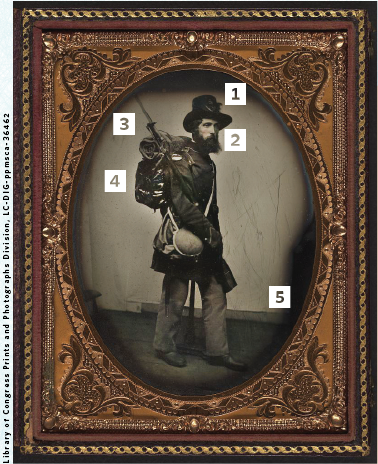
All Packed Up
- Pvt. Albert H. Davis, of Company K, 6th New Hampshire Infantry, wears a Hardee hat, named for William Hardee, a US Army officer who resigned to join the Confederacy. Cavalry and artillery soldiers usually pinned up the right side; infantry men pinned the left. Davis has done neither.
- Beards became fashionable during the war and remained common throughout the late 1860s.
- Soldiers used a wide variety of weapons. Davis has a model 1841 Mississippi rifle, a sword and a bayonet.
- Davis carries a bedroll, canteen and haversack (a single strap bag similar to a backpack).
- This studio used a plain white backdrop—you can see the bottom edge behind Davis’ legs.
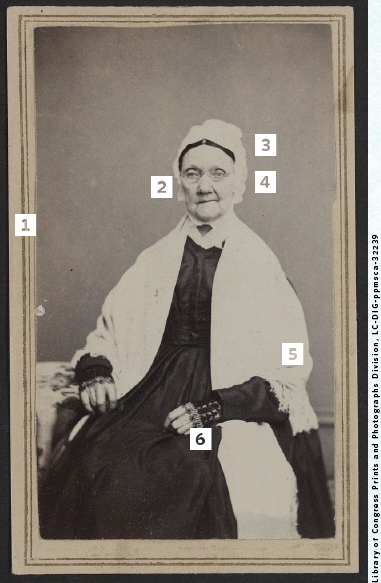
Senior Years
- Single or double gold-lined borders were common on cartes de visite during the 1860s.
- Estimate the age of a person based on appearance. This woman appears to be a senior citizen, likely born in the 18th century.
- Older women in the 1860s continued to wear muslin or linen daycaps—more popular in earlier decades—indoors and under their bonnets.
- Photo subjects during this period generally didn’t smile for the camera, but this woman attempted one.
- The conservative style of this dress, collar and bonnet suggest this woman is a member of a religious group.
- Older women were less likely to follow current fashions. This woman wears fingerless gloves called mitts, which were fashionable before the Civil War era.
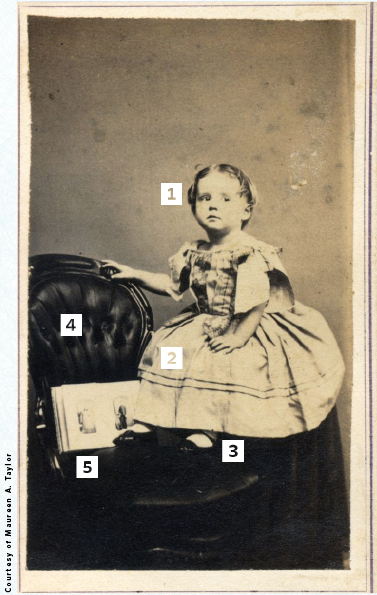
Baby Face
- The unnamed girl’s eyes are looking away from the camera—perhaps at Mom standing beside the photographer.
- Her open neckline and shoulder bows are characteristic of little girls’ dresses. The full skirt mimics women’s clothing in the Civil War period.
- Girls wore flat shoes or short boots with their dresses.
- This girl sits on a table with her legs hanging over the arm of a chair.
- This photograph album dates from the 1860s. It wasn’t uncommon at the time to use photos to include a deceased or absent loved one in the picture.
Tip: If you don’t know whether your image is a tintype, look for telltale rust spots. Still unsure? Test it: A magnet will stick to a tintype, which is actually made of iron.
Tip: A woman’s dark clothing or accessories in a Civil War-era photograph may indicate she’s mourning a deceased loved one. But because many colors resemble black in black-and-white photos, search for records as evidence a death occurred.
FamilyTreeMagazine.com is a participant in the Amazon Services LLC Associates Program, an affiliate advertising program designed to provide a means for sites to earn advertising fees by advertising and linking to Amazon.com and affiliated websites.
ADVERTISEMENT

